Article MT198
Billy Lown and Philip Hamond
two North Norfolk singers
 When Peter Kennedy and Seamus Ennis came to the North Norfolk coastal villages in search of songs and tunes - in 1952 and 1953, respectively - whilst on collecting trips for the BBC, two old soldiers gave them a handful of songs. Billy Lown of Cley-next-the-Sea was a highly regarded pub entertainer in the village, in his later years, as a singer and melodeon player; Philip Hamond of Morston, who also accompanied his singing on the melodeon, was not a public performer, playing for his own amusement at home after he had gone blind in the last few years of his life. Although the two villages are only a few miles from each other, the two men do not seem to have known each other.
When Peter Kennedy and Seamus Ennis came to the North Norfolk coastal villages in search of songs and tunes - in 1952 and 1953, respectively - whilst on collecting trips for the BBC, two old soldiers gave them a handful of songs. Billy Lown of Cley-next-the-Sea was a highly regarded pub entertainer in the village, in his later years, as a singer and melodeon player; Philip Hamond of Morston, who also accompanied his singing on the melodeon, was not a public performer, playing for his own amusement at home after he had gone blind in the last few years of his life. Although the two villages are only a few miles from each other, the two men do not seem to have known each other.
Billy Lown was born in 1875 in Lound, a village about half way between the fishing towns of Great Yarmouth and Lowestoft, into a large family of herring fishermen. He broke with family tradition, however, by declining to go to sea, instead working at various jobs on land - starting with crow scaring at the age of ten - until he joined the army. Whilst in Lound, he learned a great many songs from the fishing community in the Village Maid pub, listening outside the window as a boy.
He joined the Royal Horse Artillery on the eighth of March, 1900, and soon built up a reputation as a man very skilled in dealing with horses, a man who could get a difficult horse out of a stable by talking to it, when all others had failed. He was leader of a gun team and his granddaughter Wendy Newton-Fenbow recalls that he was present at Queen Victoria's funeral, having to sit for twelve hours on horseback. At the end of this, the horses had to be attended to before the men were allowed any rest. He was also a batman at one point and saw service in the First World War.
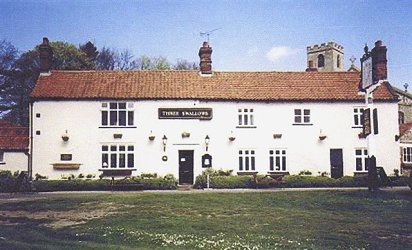 After service in the army, Billy had various jobs in various places, including publican, coal miner and agricultural worker, before settling in Cley. In this village, he was a regular in three of the pubs, The George Hotel, The Three Swallows and The Fishmongers Arms, on weekend evenings, playing the melodeon to accompany his own singing, as well as occasionally that of others, and sometimes step dancing, although he'd never turn up at the pub with his instrument, always returning home to get it if asked to play, as his grandson Richard Newton remembers: “He was a good hand at it … He was always asked, as far as I can make out. That used to amuse me, because he used to come all the way home again for his accordion. He would get there and have a pint, and if somebody asked him to, “Give us a tune, Billy,” he would walk all the way home and get it. But he would never take it out with him. He only went out Friday, Saturday and Sunday nights. Never during the week at all … He'd never drink on those nights … But he only used to drink mild beer. I never, ever remember him drinking anything else.” He doesn't appear to have played further afield, but did play at home, particularly at Christmas time, when he'd treated himself to a whisky: “He would rattle off dozens; I mean, at Christmas time, when he'd had a whisky, he was well away. He'd sing all sorts of funny songs; he had one about a crocodile … that was one of his star turns.”
After service in the army, Billy had various jobs in various places, including publican, coal miner and agricultural worker, before settling in Cley. In this village, he was a regular in three of the pubs, The George Hotel, The Three Swallows and The Fishmongers Arms, on weekend evenings, playing the melodeon to accompany his own singing, as well as occasionally that of others, and sometimes step dancing, although he'd never turn up at the pub with his instrument, always returning home to get it if asked to play, as his grandson Richard Newton remembers: “He was a good hand at it … He was always asked, as far as I can make out. That used to amuse me, because he used to come all the way home again for his accordion. He would get there and have a pint, and if somebody asked him to, “Give us a tune, Billy,” he would walk all the way home and get it. But he would never take it out with him. He only went out Friday, Saturday and Sunday nights. Never during the week at all … He'd never drink on those nights … But he only used to drink mild beer. I never, ever remember him drinking anything else.” He doesn't appear to have played further afield, but did play at home, particularly at Christmas time, when he'd treated himself to a whisky: “He would rattle off dozens; I mean, at Christmas time, when he'd had a whisky, he was well away. He'd sing all sorts of funny songs; he had one about a crocodile … that was one of his star turns.”
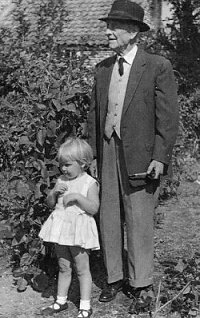 Richard Newton lived with Billy for many years: “Mother had a cottage in the grounds for a house, and he lived there, and I lived with him; cause when grandmother died, I moved in to keep him company. So I used to get a lot of his stories. He was a character. He'd look you straight in the eye. There was no messing about. He wasn't very big, but he was very broad and he wouldn't take any nonsense from anyone. Yet he wouldn't look for trouble, but I wouldn't like to have a go at him. He was like a little ferret. I remember one chap tapped him on the shoulder in the pub when he was playing and said, “I don't reckon much to that row, mate.” “Oh, don't you?” Billy said. “Well, you want to remember one thing.” “What's that?” He said, “God made crows as well as nightingales.” He'd fix you up with an answer!”
Richard Newton lived with Billy for many years: “Mother had a cottage in the grounds for a house, and he lived there, and I lived with him; cause when grandmother died, I moved in to keep him company. So I used to get a lot of his stories. He was a character. He'd look you straight in the eye. There was no messing about. He wasn't very big, but he was very broad and he wouldn't take any nonsense from anyone. Yet he wouldn't look for trouble, but I wouldn't like to have a go at him. He was like a little ferret. I remember one chap tapped him on the shoulder in the pub when he was playing and said, “I don't reckon much to that row, mate.” “Oh, don't you?” Billy said. “Well, you want to remember one thing.” “What's that?” He said, “God made crows as well as nightingales.” He'd fix you up with an answer!”
“Whenever he fell out with my Granny; whenever they had words and there was a silence; to break the silence Billy would get out his squeezebox. He'd draw up a chair right up close to her and he'd sing her a song. I mean, she couldn't do anything but laugh!” Billy seems to have carried on his music making in the village pubs, being amply paid with beer, until very late in life. Richard Newton again: “I never understood why he didn't break his neck, because he used to come home; he would come about half eleven, and I might be in bed, cause I slept downstairs, under the stairs. And he'd come home quite sozzled, and I've known him to get half way up the stairs and fall back; come all the way down again. In his seventies. And I've taken him upstairs. “Boy,” he said, “That's a rum-un,” he said. “I'll have to have another go.” I used to undress him and put him to bed and in the morning he wouldn't know anything about it. He used to have some fun, years ago.”
When the BBC collecting trips happened in the early 1950s, Billy Lown, as a village musician, would have been an obvious choice and Seamus Ennis did record him in 1953. The unaccompanied The Haselbury Girl was included in Peter Kennedy's book Folksongs of Britain and Ireland 1 and the associated sound recordings released on cassette and CDR
1 and the associated sound recordings released on cassette and CDR 2. Sadly, this is the only song which has seen the light of day. It is possible that Seamus Ennis recorded just the one song from him, but perhaps unlikely, considering his extensive repertoire and local reputation. He died, aged ninety four, in 1969.
2. Sadly, this is the only song which has seen the light of day. It is possible that Seamus Ennis recorded just the one song from him, but perhaps unlikely, considering his extensive repertoire and local reputation. He died, aged ninety four, in 1969.
Note: A recent (April 2014) search in the Full English digital archive reveals that Seamus Ennis collected seven songs from Bill Lown in Cley, and the date given is 17th November, 1955. They are:
The Bold Princess Royal (Roud 528)
The Butcher's Song (Roud 9239)
Happisburgh Market (The Haselbury Girl) (Roud 364)
The Outlandish Knight (Roud 21)
The Barley Straw (Roud 19112)
The Thrush in Australia (Roud 1763)
The Bonny Irish Boy (Roud 565).
|
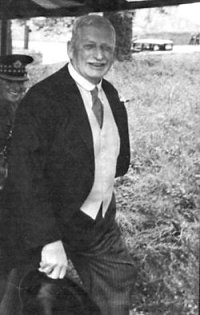 Philip Hamond was born in Twyford, Norfolk, about 1884. The 1901 census has him as Lieutenant in the 4th Norfolk Regiment, based in Kent at that time, aged seventeen. Military service seems to have been common in the family, as younger brother Charles is listed as naval cadet, aged fifteen.
Philip Hamond was born in Twyford, Norfolk, about 1884. The 1901 census has him as Lieutenant in the 4th Norfolk Regiment, based in Kent at that time, aged seventeen. Military service seems to have been common in the family, as younger brother Charles is listed as naval cadet, aged fifteen.
He served in the Boer War and was badly wounded, as his son Ned recalls: “Well, he was shot by a Boer; it was at the Battle of Ruerville; it was the last battle of the South African war, where the Boers got sort of pumping. And he'd been in a forward position, and the Boers had ridden over them. They'd shot at the Boers: they'd used all the ammunition, and having used the ammunition, my father gave the order to break the rifles, because they knew the Boers, they wanted rifles. And so he gave the order to break the rifles, which they all did. And the Boers came with their mules and they shot at them on the ground, as they went over them, but no-one was hit! So it was extraordinary.”
“So the Boers went on and got an absolute pounding by the British main troops, and then, my father said it was one of the stupidest things he ever did; he tried to repair his rifle, and he wasn't paying attention to what was going on around him. And he was trying to repair the rifle, and suddenly one of his mates said, “Look up, sir!” And he looked up and he was looking right down the barrel of this gun. So he thought, “Well, this bloke's had a bit of a nasty shock, and he's come back and he's flustered, and what I'll do is, I'll fling myself on the side,” and he flung himself over on his side and nothing happened, and then suddenly there was a bang, and the bullet went through his calf, through his thigh, in round about where you might think your appendix is, and they took it out halfway down his back; the bullet, halfway down his back, and it missed all proper, good vital organs! But, as I say, he was in a bad old way.”
Philip left the army in about 1908 and ran a garage, as Ned Hamond recalls: “It was Hamond and Hughes - old Charlie Hughes had the timberworks, and he had the garage at the front, opposite the railway station in Bury St Edmunds. He lived at Fornham All Saints with his wife Rita, and he was there until it must've been 1914, when he came to Morston Hall.”
He had only been living at Morston Hall for a matter of months when war broke out and, despite his previous experience, he joined up again, serving in tanks in France, an experience which took its toll: “We think he had a bit of a breakdown, because he was quite burnt out.” Despite this, he had a stint in America after the war, teaching the techniques of tank warfare.
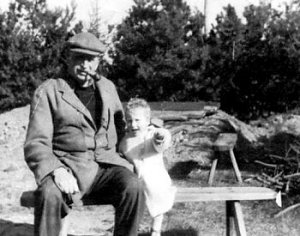 Back in Morston, he bought some land from “old Colonel Groom at Stiffkey”, building a barn, workshop and house, although his first wife Rita died in 1926, before the dwelling was completed. He had four children by that marriage, although one died in infancy, and a further three by a second marriage. A highly respected member of the community, “he was church warden at Morston. He ran Morston church!” and in this role he was instrumental in bringing about the downfall of the Rev Davidson, Rector of Stiffkey, the so-called Prostitues' Padre in 1932. The “God-fearing, upstanding pillar of the community” did not get on with the liberal, flamboyant and eccentric new rector and the resultant case made sensational news at the time.
Back in Morston, he bought some land from “old Colonel Groom at Stiffkey”, building a barn, workshop and house, although his first wife Rita died in 1926, before the dwelling was completed. He had four children by that marriage, although one died in infancy, and a further three by a second marriage. A highly respected member of the community, “he was church warden at Morston. He ran Morston church!” and in this role he was instrumental in bringing about the downfall of the Rev Davidson, Rector of Stiffkey, the so-called Prostitues' Padre in 1932. The “God-fearing, upstanding pillar of the community” did not get on with the liberal, flamboyant and eccentric new rector and the resultant case made sensational news at the time. 3
3
Music does not seem to have featured prominently in Philip Hamond's life until very late in life, until glaucoma and detached retinas made him blind, in about 1948. Ned Hamond again: “No it was just when he went blind, and he taught a little dog to lead him … had a little Jack Russell that used to lead him about, but other than that he went back into music, or he knew these songs but they all came out, because he had nothing else to do, other than the “Book from (sic) the blind” that he used to get. He used to get his old 78s sent through the post, and he had a special machine which he could operate; you know, it had a special sort of feel; and away he went. I never, ever remember him playing until he was blind. And then he took up this thing and played it. He only every did it just for himself in the smoking room … it was his little sort of study.”
Accompanying himself on the melodeon, he sang songs in a rich local accent which belies his life as an army Major and well-to-do standing in the community. He was visited by Joan Roe in August, 1951 4, who noted down the children's song Hoppity Skippity and also Still I Love Him
4, who noted down the children's song Hoppity Skippity and also Still I Love Him 5, for which she wrote the words underneath the music:
5, for which she wrote the words underneath the music:
Oh! When I was single I wore a black shawl.
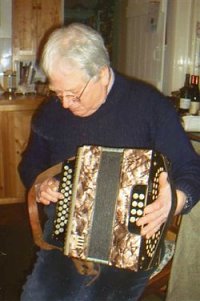 Now I got married I've nothing at all.
Now I got married I've nothing at all.
Chorus: Still I love him, I'll forgive him.
I'll go with him wherever he goes.
He bought me a handkerchief red white and blue.
Before I had wore it he tore it in two. Chorus
He come down our row and he whistled me out.
Seat out of his trousers, his shirt hanging out. Chorus
My eyes are right tired, my fingers are sore.
Gutting the herrings he brings to the shore. Chorus
There was also added in brackets underneath: Sung when hauling herrings by hand at Yarmouth, although whether this information was provided by Philip Hamond is unclear.
He was later visited by Peter Kennedy in 1952 who made sound recordings of the above two songs and also The Candlelight Fisherman 6 and a lovely version of The Foggy Dew.
6 and a lovely version of The Foggy Dew. 7 This is a perennial favourite amongst East Anglian country singers, but Philip's tune is quite unlike the usual one. Ned Hamond comments that “I always remember him saying he didn't remember the tune” and so he pressed the other one into service instead.
7 This is a perennial favourite amongst East Anglian country singers, but Philip's tune is quite unlike the usual one. Ned Hamond comments that “I always remember him saying he didn't remember the tune” and so he pressed the other one into service instead.
Suffering from very high blood pressure; poor health exacerbated by the war injuries of many years previous, Philip Hamond died in 1953, at the age of seventy.
Chris Holderness - 30.01.07
Rig-a-Jig-Jig - A Norfolk Music History Project
Notes:
1. The song is number 176 in Peter Kennedy's Folksongs of Britain and Ireland (1975; second edition Oak Publications 1984). An extra verse has been added to the written text.
2. The recording is on Folktracks CDR Ftx017: Songs of Seduction.
3. Harold Davidson was rector of Stiffkey and Morston in the early 1930s. He was present in the Norfolk villages at weekends, but spent the weekdays in Soho, amongst the homeless and prostitutes. This raised many eyebrows and caused the Bishop of Norwich to hire private investigators to try to find evidence of any wrongdoing, particularly after he was late back for a Remembrance Day service. No sound evidence was found against him, but he was defrocked in 1932. In an attempt to raise money for an appeal, he exhibited himself in a barrel in Blackpool and was killed there by being mauled by a lion.
4. Joan Roe was a music teacher, country dance enthusiast and early member of the English Folk Dance and Song Society. She noted down many tunes from Norfolk country musicians from 1935 onwards. For more information on her and tunes she collected, see Alan Helsdon: Hawk and Harnser - A Compilation of Traditional Norfolk Dance Tunes (Quanting Publications, 2004). I suspect that Peter Kennedy may have been given some contacts by Joan Roe through the EFDSS organisation. As well as both visiting Philip Hamond, Joan Roe noted down song tunes from Alfred Barker of Burgh-next-Aylsham, who was later recorded by Kennedy.
5. This song appears on Folktracks CDR Ftx328 Norfolk Village Songs and Dances.
6. This song is number 219 in Folksongs of Britain and Ireland, as above, and can be heard on Ftx021: Songs of the Trades. Peter Kennedy notes that it was composed by Philip Hamond, but the story is a very well-known one indeed amongst the fishing community. See, for example, John Seymour: Sailing Through England (Eyre and Spottiswoode, 1956). The song was also recorded by Suffolk bargeman Bob Roberts on Ftx515: Coastal Songs and Sailors Ashore and on Topic LP 12TS361 Songs from the Sailing Barges. A L Lloyd, in the LP notes, states that it “comes from the repertory of fishermen.”
7. The song is number 174 in Folksongs of Britain and Ireland, as above, and can be heard on Ftx017 and Ftx328, as above.
Article MT198
Site designed and maintained by Musical Traditions Web Services Updated: 2.5.14
 When Peter Kennedy and Seamus Ennis came to the North Norfolk coastal villages in search of songs and tunes - in 1952 and 1953, respectively - whilst on collecting trips for the BBC, two old soldiers gave them a handful of songs. Billy Lown of Cley-next-the-Sea was a highly regarded pub entertainer in the village, in his later years, as a singer and melodeon player; Philip Hamond of Morston, who also accompanied his singing on the melodeon, was not a public performer, playing for his own amusement at home after he had gone blind in the last few years of his life. Although the two villages are only a few miles from each other, the two men do not seem to have known each other.
When Peter Kennedy and Seamus Ennis came to the North Norfolk coastal villages in search of songs and tunes - in 1952 and 1953, respectively - whilst on collecting trips for the BBC, two old soldiers gave them a handful of songs. Billy Lown of Cley-next-the-Sea was a highly regarded pub entertainer in the village, in his later years, as a singer and melodeon player; Philip Hamond of Morston, who also accompanied his singing on the melodeon, was not a public performer, playing for his own amusement at home after he had gone blind in the last few years of his life. Although the two villages are only a few miles from each other, the two men do not seem to have known each other.
 After service in the army, Billy had various jobs in various places, including publican, coal miner and agricultural worker, before settling in Cley. In this village, he was a regular in three of the pubs, The George Hotel, The Three Swallows and The Fishmongers Arms, on weekend evenings, playing the melodeon to accompany his own singing, as well as occasionally that of others, and sometimes step dancing, although he'd never turn up at the pub with his instrument, always returning home to get it if asked to play, as his grandson Richard Newton remembers: “He was a good hand at it … He was always asked, as far as I can make out. That used to amuse me, because he used to come all the way home again for his accordion. He would get there and have a pint, and if somebody asked him to, “Give us a tune, Billy,” he would walk all the way home and get it. But he would never take it out with him. He only went out Friday, Saturday and Sunday nights. Never during the week at all … He'd never drink on those nights … But he only used to drink mild beer. I never, ever remember him drinking anything else.” He doesn't appear to have played further afield, but did play at home, particularly at Christmas time, when he'd treated himself to a whisky: “He would rattle off dozens; I mean, at Christmas time, when he'd had a whisky, he was well away. He'd sing all sorts of funny songs; he had one about a crocodile … that was one of his star turns.”
After service in the army, Billy had various jobs in various places, including publican, coal miner and agricultural worker, before settling in Cley. In this village, he was a regular in three of the pubs, The George Hotel, The Three Swallows and The Fishmongers Arms, on weekend evenings, playing the melodeon to accompany his own singing, as well as occasionally that of others, and sometimes step dancing, although he'd never turn up at the pub with his instrument, always returning home to get it if asked to play, as his grandson Richard Newton remembers: “He was a good hand at it … He was always asked, as far as I can make out. That used to amuse me, because he used to come all the way home again for his accordion. He would get there and have a pint, and if somebody asked him to, “Give us a tune, Billy,” he would walk all the way home and get it. But he would never take it out with him. He only went out Friday, Saturday and Sunday nights. Never during the week at all … He'd never drink on those nights … But he only used to drink mild beer. I never, ever remember him drinking anything else.” He doesn't appear to have played further afield, but did play at home, particularly at Christmas time, when he'd treated himself to a whisky: “He would rattle off dozens; I mean, at Christmas time, when he'd had a whisky, he was well away. He'd sing all sorts of funny songs; he had one about a crocodile … that was one of his star turns.”
 Richard Newton lived with Billy for many years: “Mother had a cottage in the grounds for a house, and he lived there, and I lived with him; cause when grandmother died, I moved in to keep him company. So I used to get a lot of his stories. He was a character. He'd look you straight in the eye. There was no messing about. He wasn't very big, but he was very broad and he wouldn't take any nonsense from anyone. Yet he wouldn't look for trouble, but I wouldn't like to have a go at him. He was like a little ferret. I remember one chap tapped him on the shoulder in the pub when he was playing and said, “I don't reckon much to that row, mate.” “Oh, don't you?” Billy said. “Well, you want to remember one thing.” “What's that?” He said, “God made crows as well as nightingales.” He'd fix you up with an answer!”
Richard Newton lived with Billy for many years: “Mother had a cottage in the grounds for a house, and he lived there, and I lived with him; cause when grandmother died, I moved in to keep him company. So I used to get a lot of his stories. He was a character. He'd look you straight in the eye. There was no messing about. He wasn't very big, but he was very broad and he wouldn't take any nonsense from anyone. Yet he wouldn't look for trouble, but I wouldn't like to have a go at him. He was like a little ferret. I remember one chap tapped him on the shoulder in the pub when he was playing and said, “I don't reckon much to that row, mate.” “Oh, don't you?” Billy said. “Well, you want to remember one thing.” “What's that?” He said, “God made crows as well as nightingales.” He'd fix you up with an answer!”
 Philip Hamond was born in Twyford, Norfolk, about 1884. The 1901 census has him as Lieutenant in the 4th Norfolk Regiment, based in Kent at that time, aged seventeen. Military service seems to have been common in the family, as younger brother Charles is listed as naval cadet, aged fifteen.
Philip Hamond was born in Twyford, Norfolk, about 1884. The 1901 census has him as Lieutenant in the 4th Norfolk Regiment, based in Kent at that time, aged seventeen. Military service seems to have been common in the family, as younger brother Charles is listed as naval cadet, aged fifteen.
 Back in Morston, he bought some land from “old Colonel Groom at Stiffkey”, building a barn, workshop and house, although his first wife Rita died in 1926, before the dwelling was completed. He had four children by that marriage, although one died in infancy, and a further three by a second marriage. A highly respected member of the community, “he was church warden at Morston. He ran Morston church!” and in this role he was instrumental in bringing about the downfall of the Rev Davidson, Rector of Stiffkey, the so-called Prostitues' Padre in 1932. The “God-fearing, upstanding pillar of the community” did not get on with the liberal, flamboyant and eccentric new rector and the resultant case made sensational news at the time.
Back in Morston, he bought some land from “old Colonel Groom at Stiffkey”, building a barn, workshop and house, although his first wife Rita died in 1926, before the dwelling was completed. He had four children by that marriage, although one died in infancy, and a further three by a second marriage. A highly respected member of the community, “he was church warden at Morston. He ran Morston church!” and in this role he was instrumental in bringing about the downfall of the Rev Davidson, Rector of Stiffkey, the so-called Prostitues' Padre in 1932. The “God-fearing, upstanding pillar of the community” did not get on with the liberal, flamboyant and eccentric new rector and the resultant case made sensational news at the time. Now I got married I've nothing at all.
Now I got married I've nothing at all.